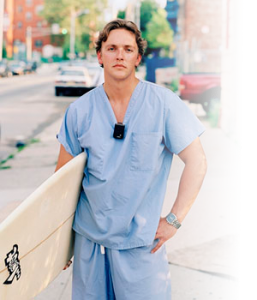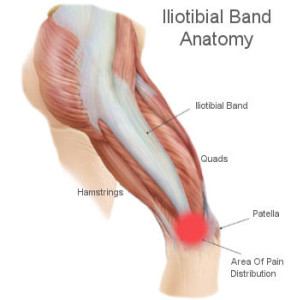Stand Up Paddling and Iliotibial Band ITB Syndrome
 Aloha, I’d like to introduce Clay Everline MD, a new Maui resident and Board Certified in Sports Medicine and Internal Medicine. He has so kindly offered to share his expertise in all realms of sports medicine with Suzie Trains Maui. He is a true waterman. Thanks Clay for your contribution!
Aloha, I’d like to introduce Clay Everline MD, a new Maui resident and Board Certified in Sports Medicine and Internal Medicine. He has so kindly offered to share his expertise in all realms of sports medicine with Suzie Trains Maui. He is a true waterman. Thanks Clay for your contribution!
Suzie
Iliotibial band (ITB) syndrome is an overuse problem that is often seen in bicyclists, runners, and long-distance walkers. Personally, it has been noted while Backcountry Skiing and Stand-Up Paddling (SUP). Many people ask me what causes pain on the outside of the knee just above the knee joint. It is ITB syndrome and it can be problematic. The discomfort may be so intense as to discourage you from participating in the often long and rewarding sessions of SUP and other endeavors. So what can be done about it?
Ice massage is one of the best initial therapies for ITB syndrome. Hold a cube of ice in a napkin and massage the inflamed area until the cube has melted. It could take up to 20 minutes. Do this 1-2 times daily. A Cho-Pat strap or similar compression tape may prevent overstretching and inflammation, but ultimately it comes down to adjusting biomechanics and muscle balance. The following exercises should help as well:
napkin and massage the inflamed area until the cube has melted. It could take up to 20 minutes. Do this 1-2 times daily. A Cho-Pat strap or similar compression tape may prevent overstretching and inflammation, but ultimately it comes down to adjusting biomechanics and muscle balance. The following exercises should help as well:
- Iliotibial band stretch: Standing: Cross one leg in front of the other leg and bend down and touch your toes. You can move your hands across the floor toward the front leg and you will feel more stretch on the outside of your thigh on the other side. Hold this position for 15 to 30 seconds. Return to the starting position. Repeat 3 times. Reverse the positions of your legs and repeat.
- Iliotibial band stretch: Side-leaning: Stand sideways near a wall. Place one hand on the wall for support. Cross the leg farthest from the wall over the other leg, keeping the foot closest to the wall flat on the floor. Lean your hips into the wall. Hold the stretch for 15 seconds, repeat 3 times, and then switch legs and repeat the exercise another 3 times.
- Standing calf stretch: Facing a wall, put your hands against the wall at about eye level. Keep one leg back with the heel on the floor, and the other leg forward. Turn your back foot slightly inward (as if you were pigeon-toed) as you slowly lean into the wall until you feel a stretch in the back of your calf. Hold for 15 to 30 seconds. Repeat 3 times and then switch the position of your legs and repeat the exercise 3 times. Do this several times each day.
- Hamstring stretch on wall: Lie on your back with your buttocks close to a doorway, and extend your legs straight out in front of you along the floor. Raise one leg and rest it against the wall next to the door frame. Your other leg should extend through the doorway. You should feel a stretch in the back of your thigh. Hold this position for 15 to 30 seconds. Repeat 3 times and then switch legs and do the exercise again.
- Quadriceps stretch: Stand an arm’s length away from the wall with your injured leg farthest from the wall. Facing straight ahead, brace yourself by keeping one hand against the wall. With your other hand, grasp the ankle of your injured leg and pull your heel toward your buttocks. Don’t arch or twist your back. Keep your knees together. Hold this stretch for 15 to 30 seconds.
- Wall squat with a ball: Stand with your back, shoulders, and head against a wall and look straight ahead. Keep your shoulders relaxed and your feet 2 feet away from the wall and a shoulder’s width apart. Place a soccer or basketball-sized ball behind your back. Keeping your back upright, slowly squat down to a 45-degree angle. Your thighs will not yet be parallel to the floor. Hold this position for 10 seconds and then slowly slide back up the wall. Repeat 10 times. Build up to 3 sets of 10.
- Side-lying leg lift: Lying on your uninjured side, tighten the front thigh muscles on your top leg and lift that leg 8 to 10 inches away from the other leg. Keep the leg straight and lower slowly. Do 3 sets of 10.
- Knee stabilization: Wrap a piece of elastic tubing around the ankle of the uninjured leg. Tie a knot in the other end of the tubing and close it in a door.
- Stand facing the door on the leg without tubing and bend your knee slightly, keeping your thigh muscles tight. While maintaining this position, move the leg with the tubing straight back behind you. Do 3 sets of 10.
- Turn 90 degrees so the leg without tubing is closest to the door. Move the leg with tubing away from your body. Do 3 sets of 10.
- Turn 90 degrees again so your back is to the door. Move the leg with tubing straight out in front of you. Do 3 sets of 10.
- Turn your body 90 degrees again so the leg with tubing is closest to the door. Move the leg with tubing across your body. Do 3 sets of 10.
Hold onto a chair if you need help balancing. This exercise can be made even more challenging by standing on an Indo Board with Flo-cushion while you move the leg with tubing.
- Iliotibial band stretch: Side-bending: Cross one leg in front of the other leg and lean in the opposite direction from the front leg. Reach the arm on the side of the back leg over your head while you do this. Hold this position for 15 to 30 seconds. Return to the starting position. Repeat 3 times and then switch legs and repeat the exercise. This exercise can be made even more challenging by standing on an Indo Board with the IndoFlo-cushion
- Clam exercise: Lie on your uninjured side with your hips and knees bent and feet together. Slowly raise your top leg toward the ceiling while keeping your heels touching each other. Hold for 2 seconds and lower slowly. Do 3 sets of 10 repetitions. This works the hip abductors that stabilize the iliotibial band.
Your doctor may also prescribe an anti-inflammatory. Piroxicam has been shown in the Sports Medicine literature to speed sprain and strain healing times, but there is still controversy. If you have any reservations, stick with the exercises and maintain good posture. Surgery is very rarely necessary. Should you have any questions, email me through my websites: www.everlinemd.com or www.boardsportsdoc.com. Be well!
Clayton Everline MD, DMO, CSCS
Board Certified in Sports Medicine and Internal Medicine
Clinical Assistant Professor of Orthopaedic Surgery
Seton Hall University School of Health and Medical Sciences
The Waves of Health (www.thewavesofhealth.org)





I did SUP this year when I was down in Hawaii for the Ironman World Championships. It rocks! If you do get knee pain that is related to IT Band Friction Syndrome, you should definitely check out the website: https://www.bulletproofknee.com .
Good luck.
Ben